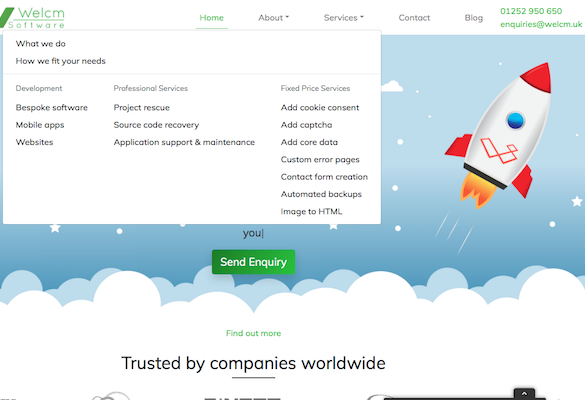A successful website is arguably a business's most effective method of standing out from the crowd. In this article we're going to run through 10 things you should look at to make your website as effective as possible. Depending on your technical ability you may be able to improve all the aspects we discuss here. If your area of expertise lies elsewhere you can get in touch with us and we will help.
1. Easy To Read
Most people don’t read websites; they scan them.
Contrast and a clear hierarchy help a website’s readability by making the content pleasant to read and easy to follow.
A clear contrast between text colour and its background is very important. Good websites will never use a black background with dark- coloured text or a white background with light- coloured text.
A clear hierarchy helps people identify important sections of a website. Headings are used to break up the website content into sections and small blocks of text are used to help users read the content more easily.
2. Search Engine Optimisation
Search engine optimisation (SEO) helps bring visitors to a website.
Bringing relevant users to a website plays a key role in its growth. It is not just about getting visitors, it is about getting the right visitors - potential customers that will appreciate and pay for your products / services.
Good SEO takes time and effort to produce results. In time it will strengthen your site and improve the return on your investment. Strategies such as advertising campaigns, creating and promoting quality content frequently, getting backlinks, conducting keyword research and cleaning up code will all help.
3. Original Content
High quality websites don't simply sell things; they cater to their users' needs.
Good, fresh original content grabs a visitor’s attention, invites them to get involved, share it and come back for more.
Google places a high value on content that is relevant and interesting for users. As such, creating quality, original content is very effective when it comes to making a good website.
Some companies will do this by regularly writing relevant articles or blog posts. Others create pages that address customers' frequently asked questions. Both methods achieve success, it is just a matter of optimising and promoting the content.
4. Beautiful Design
Beautiful, up-to-date design makes a site visually pleasing and more memorable.
A good website is built around a theme that reflects the brand's market and personality. Good website design also takes user- experience (UX) into account and creates with these things in mind.
It is very important to make a website responsive so it works equally well on desktop and mobile devices. Lastly, good websites are designed to be accessible to all users, from those who are colourblind to users with more restrictive disabilities.
5. Speed
Good websites load their pages quickly.
Users don’t want to wait for pages to load. They want the information quickly and without delay. Studies show that if a page loads slowly the user will leave the website and find another one that will deliver quickly.
High quality code coupled with optimised graphics, video and audio give a website the necessary speed it needs to load quickly. Google places significant importance on page load speed. Slow websites are ranked lower. As such, page speed plays a major factor when it comes to staying ahead of your competitors.
6. Clean & Validated Code
Low quality, messy or old code reduces a website’s search engine ranking.
When digital marketers and web developers analyse a website to see what can be improved, they often look at the website’s code first. It affects your Google rank and page load speed.
Validated code will help cross browser compatibility. Following current web standards and best practice guidelines helps ensure that the site will display correctly in different browsers. Clean code can also save you time and money because troubleshooting and bug fixing is easier.
7. Analytics & Tracking
Good websites measure their traffic and track user journeys.
Tracking website traffic helps show how well a website is performing. It allows businesses to assess their marketing efforts and target users, so creating a more effective website.
Analytics tools allow businesses to see where their vistors are engaging with the website. These engagements can be completing a purchase, filling out a form or simply reading a blog post. Equally importantly they also highlight where users are leaving the site.
To ensure a website is as effective as possible, it is essential to monitor what’s working and what’s not. This enables businesses to make evidence-based improvements.
8. Backlinks
Good websites promote themselves on high-ranking websites.
Backlinks, particularly from high- ranking websites, help improve a website's search engine ranking.
Creating high-quality original content encourages other websites to link to it. Blog articles can also be submitted to other websites. Including links in the articles will help drive traffic to your website.
Getting backlinks is like word-of-mouth referrals on the web. If leading websites in your industry have links to your website it creates valuable traffic including prospective clients. Add on the improvements in search engine ranking and the importance of backlinks is clear.
9. Organised & Structured
Good websites follow a defined structure and are well organised.
Being well organised makes a website user- friendly. Good websites are not cluttered. They are clean and professional. They are also built with a target audience in mind.
By creating a well thought out structure for your website, users will be able to navigate your site more easily and find the content they want. A clearly defined, well organised structure allows Google to easily crawl and index your website.
10. Simple Navigation
Successful websites have simple, clear and user-friendly navigation.
You need to ensure users can find what they want quickly and easily. If they can't do so they will get frustrated and leave. As such, it is important to include an intuitive navbar on your website.
If you have a large website with a lot of content, you should consider using a mega menu, also known as an uber menu. These type of menus build on a typical drop-down menu. Links are grouped together and organised into columns within the dropdown.
If you would like a copy of this article as an e-book please click here.








